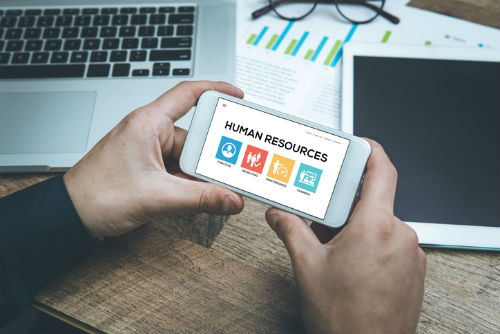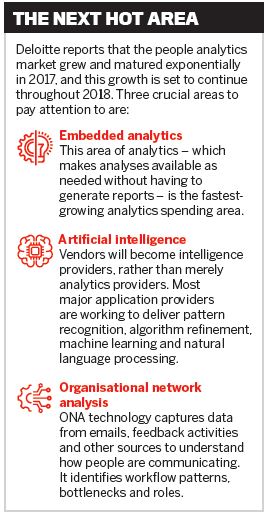
AI has made workplace tech seamless thanks to AI that is increasingly ‘human’, writes Iain Hopkins

AI has made workplace tech seamless thanks to AI that is increasingly ‘human’, writes Iain Hopkins
“Don’t be slave to technology – manage your phone; don’t let it manage you.” Those words from entrepreneur Richard Branson resonate in 2018 more than ever before. Just about any tech developer will tell you that their primary objective in the creation of new apps and platforms is to enhance the lives of the end users.
The same applies to HR tech. Zoom.ai, a company that develops automated assistants that can manage routine tasks for busy offices, is just one example of a start-up looking to transform the user experience. The AI helper is programmed to schedule meetings, set reminders and briefings, generate documents, transcribe recordings, set Uber rides, search for flights, pull up contact information, and arrange for peer-to-peer introductions.
Zoom.ai aims to help people get up to speed on menial tasks, with the ultimate aim of raising productivity. The start-up was the winner of the 2017 HR Tech Den, the launchpad of start-ups in the HR and tech space, and the flagship program of the HR Tech Summit Toronto. A similar event is taking place at HR Tech Summit Sydney in September (see boxout).
“We build technology that resonates with employees,” says Zoom.ai CEO Roy Pereira. “We’ve never had a better time than now to transform, powered by the growth of cloud applications and exponential technology leveraging AI, machine learning and natural language processing.”
Making the workday “more human” is the breakthrough innovation many have been waiting for, Pereira adds. That sentiment is echoed by Philip Grauer, director of product management at CGI. He says the objective of CGI’s Njoyn – a leader in the recruitment management and applicant tracking space – is to ensure that technology makes the employee experience easier, more productive and more enjoyable.
“Technology needs to be designed from the ground up with a high degree of usability,” Grauer says. “It should address real-world problems and aim to simply provide access to the needed data at the point of service.”
This focus on the end user is the result of the consumerisation of technology, whereby functions readily available in everyday tech (smartphones, etc.) are now part of workplace tech. This has provided employees with easier and faster access to real-time information that allows them to do their jobs. It also means technology is more intuitive than ever before – today there’s no need for lengthy instruction manuals or training sessions.
“The fact that consumerisation has taken place allows new entrants into the market and lowers the cost for users of these services,” Grauer says. “This includes new mobile services, as well as value-added integrations between what were, in the past, distinct stand-alone solutions. Examples of such integrations within the HR world include an applicant tracking solution talking with a background check provider or an applicant tracking solution sharing data with a video interview solution.”

A reasonably new development being applied to the workplace is artificial intelligence – and again, this has been influenced by consumer technology such as Apple’s Siri. Within the recruitment process, for example, Grauer says AI lends itself nicely to automatic chat modules. This includes ‘candidate ask’ – where the candidate can ask questions regarding the company and receives predefined answers. The chat algorithm will continuously learn based on the questions posed.
In addition, there is ‘candidate capture’, where the recruitment page will actively welcome and pose questions to the candidate and, based on their answers, route them to the appropriate open jobs. The system will capture key candidate information along the way and thereby minimise candidate drop-out rates during the application process.
Design thinking – essentially, starting with the problem and working backwards to find a solution – has been critical to this process. “We need to understand the current pain points and effectively address them with new solutions,” Grauer says.
The impact of design thinking might be most profoundly experienced through what Deloitte describes as digital ‘appification’. Rather than building an onboarding system, a learning system, a performance management system, and a collaboration and coaching system, design thinking brings these solutions together in seamless apps that improve employee experiences across the board.
Designing tech in such a way ensures it remains rooted in real-life challenges. Part of the criticism of AI is that it lacks the ‘human touch’; it can be frustrating and ultimately result in negative customer (or employee) interactions with an organisation. Rurik Bradbury, global head of conversational strategy at LivePerson – a tech company that develops products for online messaging, marketing and analytics – says this is where conversational designers come in.
“Bots can’t learn on their own; they need the right teachers and managers,” he says. “Conversational designers write scripts for the bots and teach them how to respond to queries. I heard a story about one customer who was messaging a brand and mentioned that she lost her husband. The bot responded with, ‘Great! I’d be happy to help you with that’. The bot misinterpreted her intent and thought she was trying to track a lost shipment. Designers write empathy into the bot so these situations won’t happen. AI still has a long way to go, but we’re well on our way to interacting with AI as if it were a human.”
The future may already be here. Duplex is the latest machine learning experiment to come out of Google. This isn’t your average chatbot. It’s a robocaller trained to book reservations and hold phone conversations on your behalf. The catch: the bot sounds all too human.
Duplex: “Hi, I’m calling to book a woman’s haircut for a client. I’m looking for something on May 3rd.”
Staff: “Sure, give me one second.”
Duplex: “Mm-hmm ...”
The neophyte AI assistant plays the part of a human so naturally when it places a call that the person on the other end of the conversation might actually think they were speaking to a human.
On the back end, Duplex is powered by Google’s advancements in natural language processing, deep learning and text-to-speech technology. On the B2C front, this super bot demonstrates so-called speech disfluencies – the pauses in conversation marked with the uhh’s, umm’s and hmm’s – associated with moments of careful thought. This has been deliberately baked into the system for the AI to “signal in a natural way that it is still processing”, according to the engineers behind the project.
Keeping track
For now, HR professionals might be concerned about the limited insight they have into how, when and where employees are using technology. If so, they can rest easy – there’s a tech solution to shed some light on it.
“If you don’t know how your employees are using their software, you really don’t know whether they’re engaged and productive or not,” says Knoa Software CEO Brian Berns. “User analytics provide crucial insight into how employees interact with their enterprise systems so that organisations can get to the root of any problems and come up with viable solutions.”
Knoa UEM is a user experience management solution that provides full visibility into employees’ interactions with enterprise software, shedding light on application usage, adoption and workflows. With this insight into the actual employee experience, organisations can better understand the process bottlenecks, inefficient workflows and trouble areas their employees face on a daily basis.
“Workers expect user-friendly functionality in their workplaces, and they have a right to expect that,” Berns says. “Enterprises can’t expect employees to be satisfied with plodding through decades-old technology when they’re used to intuitive, seamless technology on their home laptops, tablets and cell phones.”